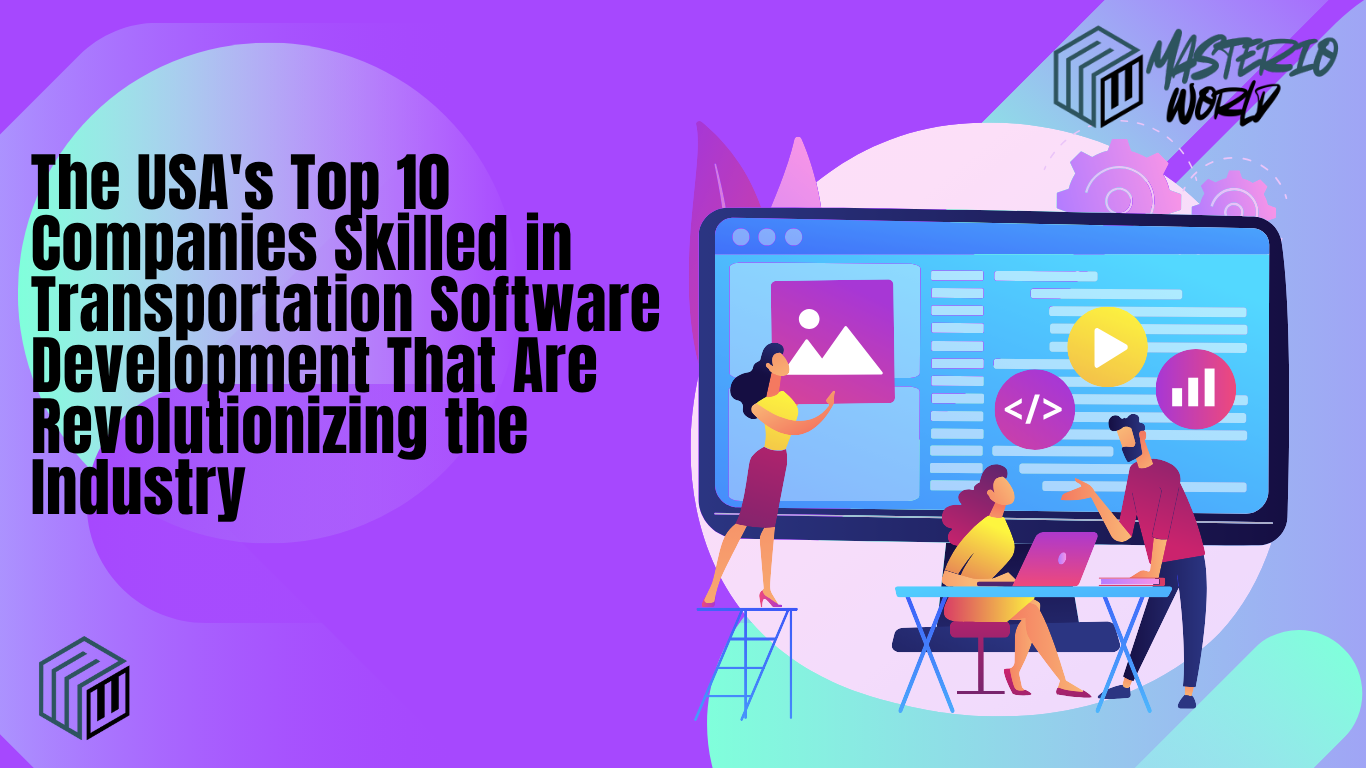Transportation software development has come to the forefront of ultramodern logistics, freight, and mobility diligence. As the U.S. frugality continues to grow, companies are seeking smarter, scalable, and more effective ways to manage the movement of goods and people. From route optimization to predictive conservation, digital results are revolutionizing how transportation is handled.
________________________________________
The demand for transportation software development has surged post-pandemic, as businesses need better shadowing, robotization, and data intelligence to stay competitive. In this companion, we’ll highlight the top 10 transportation software companies in the USA and how they’re shaping the future.
________________________________________
Why Transportation Software Matters in 2025 and Beyond
In 2025, force chains have become more digitized, consumers anticipate real-time shadowing, and sustainability targets are stricter than ever. Transportation software bridges the gap between legacy systems and unprepared logistics by offering
- Increased functional effectiveness
- Reduced costs and time-out
- Advanced safety and compliance
- Sustainability shadowing and carbon emission control.
These aren’t just software benefits, they’re business imperatives. Companies ignoring the transportation digitization threat are falling behind.
________________________________________
Crucial Features of Effective Transportation Software.
To stay competitive, leading companies offer transportation software equipped with high-impact features similar to
Route Optimization
Effective routing reduces energy use, delivery times, and wear on vehicles. Algorithms consider business, rainfall, and delivery windows.
Real-time Tracking
From line movement to payload status, live shadowing boosts visibility and client satisfaction. GPS, RFID, and detector data are generally used.
Fleet Management
Asset shadowing, energy operation, motorist gesture, and conservation are handled through a centralized dashboard.
Prophetic conservation
Smart diagnostics alert line directors before breakdowns do. This minimizes unplanned time-outs and extends vehicle lifetime.
________________________________________
Criteria for opting for the Top Companies
To determine the USA’s stylish transportation software companies, we estimated
- Proven moxie in transportation and logistics
- Innovation in AI, IoT, and robotization
- customer portfolio and enterprise impact
- Security and scalability of software
- E-E-A-T (Experience, moxie, Authoritativeness, responsibility),
________________________________________
Trimble Inc.
Headquarters Sunnyvale, CA
Specialty: Fleet optimization, telematics, logistics results.
Trimble leads with connected transportation platforms. They give software that helps carriers reduce energy consumption and streamline routes with geospatial perceptivity.
________________________________________
Omnitracs
Headquarters Dallas, TX
Specialty: Fleet intelligence, safety, ELD compliance
Omnitracs innovated electronic logging and now offers end-to-end line operation and AI- AI-grounded motorist analytics.
________________________________________
KeepTruckin (Motive)
Headquarters San Francisco, CA
Specialty motorist safety, smart dashcams, and line visibility
Motive leverages AI to automate workflows, ameliorate motorist safety, and ensure DOT compliance.
________________________________________
Samsara
Headquarters: San Francisco, CA
Specialty: IoT-powered transportation monitoring.
Samsara integrates real-time GPS shadowing, videotape telematics, and asset application across different lines and logistics enterprises.
________________________________________
Geotab
Headquarters Oakville, ON (with major U.S. presence)
Specialty Open-platform line telematics
Geotab’s modular software empowers companies to make custom line dashboards, ensuring non-supervisory compliance and emissions monitoring.
________________________________________
McLeod Software
Headquarters Birmingham, AL
Specialty Trucking and brokerage software
McLeod Software enhances LTL and FTL operations, streamlining dispatch, billing, and order entry systems.
________________________________________
Project44
Headquarters: Chicago, IL
Specialty: Real-time force chain visibility
Project44 connects shippers, carriers, and logistics mates, giving unmatched data on payload health and delivery performance.
________________________________________
Oracle Transportation Management
Headquarters: Redwood Shores, CA
Specialty: Enterprise transportation unit
Part of Oracle’s larger ERP suite, this platform handles everything from order operations to freight agreements at scale.
________________________________________
TMW Systems (Trimble Company)
Headquarters: Beachwood, OH
Specialty: Trucking ERP and optimization
TMW delivers software for asset-grounded and non-asset carriers, with deep integrations into storehouse systems.
________________________________________
Manhattan Associates
Headquarters: Atlanta, GA
Specialty: Supply chain and TMS software.
Manhattan’s Transportation Management System integrates storehouse and transportation functions, offering a flawless logistics ecosystem.
________________________________________
Trends Shaping the Future of Transportation Software
Artificial Intelligence and Machine Learning
AI analyzes literal data to suggest briskly, cheaper, and safer routes. Machine literacy adapts to real-time changes in the force chain.
IoT and Sensor Integration Sensors in vehicles and means allow data collection on temperature, position, machine health, and more, streamlining automated cautions and opinions.
Blockchain for Logistics ensures translucency and security in freight attestation, reducing fraud and paperwork crimes.
________________________________________
Challenges in Transportation Software Development
- Integration with outdated heritage systems
- Cybersecurity pitfalls
- High upfront costs for advanced platforms
- Data load from IoT bias
Non-supervisory compliance across authorities. Despite these hurdles, top companies are overcoming challenges through modular design, platform-based architecture, and strong data governance.
________________________________________
Benefits for Logistics, Freight, and Mobility diligence
- Cost Reduction: Optimize energy, labor, and conservation charges
- effectiveness Earnings Streamline operations through robotization
- Client Experience: Real-time delivery updates and ETAs
- Scalability, pay-per-click results grow with your business. How These Companies Demonstrate E-E-A-T in the Field
________________________________________
Each of the top 10 companies exhibits
- Experience Times of sphere-specific systems in logistics
- Expertise: Advanced use of AI, ML, and pall platforms
- Authoritativeness Cited in Gartner, Forbes, and industry whitepapers
- Responsibility: Proven uptime, SOC 2 compliance, and security
Their software isn’t just dependable, it’s also admired by enterprises, startups, and government agencies.
________________________________________
Conclusion: The Road Ahead for Smart Transport.
Transportation software development is no longer voluntary; it’s foundational. The top 10 companies stressed they are transubstantiating American logistics with intelligent results that reduce costs, ameliorate safety, and prepare lines for the future. From IoT-powered platforms to AI-driven analytics, these companies are erecting the roadways of hereafter digitally. As diligence evolves, one thing’s for sure: digital transportation results will continue to drive business metamorphosis, environmental responsibility, and global competitiveness.
________________________________________
FAQs
It involves creating digital results to manage logistics, line operations, delivery systems, and real-time shadowing in transportation.
It improves effectiveness, reduces costs, enhances client satisfaction, and helps meet environmental and compliance conditions.
Companies like Samsara, KeepTruckin, and Geotab are leaders in line shadowing, offering GPS, ELD, and videotape telematics.
Yes, AI is generally used for predictive analytics, route optimization, and motorist gestures.
Absolutely. Numerous providers offer scalable pricing and modular platforms that suit small lines and independent drivers.
A good starting point is Gartner’s Supply Chain coffers, which includes detailed perspectives and software reviews.

